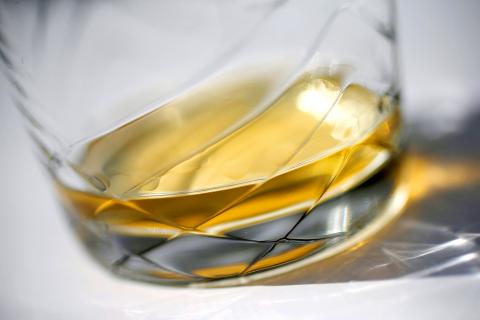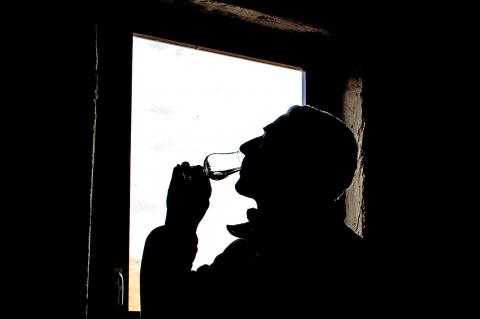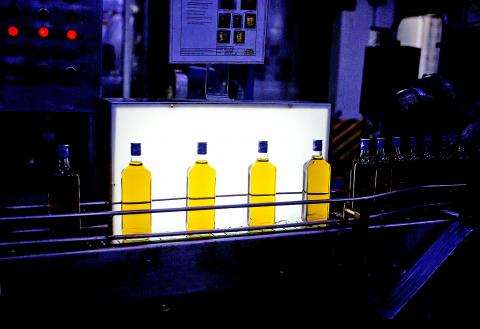As the climate crisis accelerates, fueling powerful storms, unprecedented droughts and wildfires, more consumers are focused on making purchases that are environmentally sensitive.
Companies hoping to capture their dollars are increasingly trying to do something — anything — to show they are part of the solution and not the problem.
Some of them are in the alcohol industry, which with its reliance on water, wood and energy to distill and ship its products, has quite the carbon footprint. There are a growing number of booze makers putting their own spin on making greener alcohol.

Photo: Reuters
ENDANGERED OAK
Given the critical role wood plays in the production of spirits, protecting trees has become a common focal point. Westland Distillery’s Garryana whiskey, limited to about 3,000 bottles a year, is a hit with aficionados and collectors because of its unique, piquant flavors. It’s also a good example of how spirits makers are becoming more ecologically aware.
For the past four years, the Seattle-based company has made Garryana with a blend of its single malt whiskeys, some of which were aged in barrels made of Garry Oak — an almost extinct Pacific Northwest species. (The barrels are made from trees that fell naturally.)

Photo: AFP
“Our interest in Garry Oak was initially a purely whiskey-focused one,” said Westland co-founder and Master Distiller Matt Hofmann. “But as we learned more about our native species of oak, we saw firsthand how severely endangered it has become.”
Garry Oak now only grows in five percent of its former habitat, Hofmann said. The distillery’s Garry Oak Project with land conservationist organization Forterra involves planting new trees throughout Washington state while protecting existing stands. Commercial Director Chris Riesbeck said employees take part, working “the land twice per year to ensure that we are setting a good example for land stewardship.”
“By using this oak for whiskey production, we’re shining a bright spotlight on Garry Oak,” Hofmann said. “The broader ecosystems supported by Garry Oaks are good for the region — the environment, the wildlife and the people.”

Photo: Bloomberg
WATER CYCLE
Roberto Serrales, a sixth-generation rum maker with a doctorate in chemical engineering, said there are many ways alcohol production can be harmful to the planet — including packaging, shipping and fuel consumption. The number one problem, however, is water waste that needs to be treated before being returned to the environment.
“A large distillery that is producing 50,000 [gallons] per day will generate around 400,000 gallons of wastewater per day,” said Serrales, who consults on environmental issues for Don Q rum and other distilleries. “A large distillery like that may typically operate on average around 300 days per year.”
Jason Nally is focused on water, too. As Maker’s Mark’s Environmental Champion (his real title), he conceded that the high climate cost of shipping spirits is something that — for now — can’t be avoided. Kentucky-based Maker’s Mark is instead focusing sustainability efforts on the “activity inside the distillery,” Nally said. And that means water.
“Production begins with water, which is why we created the protected watershed around our lakes,” Nally said. “By owning, managing and preserving our own water source, we’ve eliminated the need for piped-in, chemically treated and cleaned water from a municipal source, allowing us to rely instead on the natural limestone of our lakes to filter our water.”
Nally said that wastewater resulting from distillation is treated before it’s released, and spent grains, or stillage, go to local farms where they’re re-purposed as livestock feed.
“While we certainly don’t claim to have ‘solved’ each and every impact that our industry has on the environment,” he said, “we care about our planet’s future, and recognize the role we play.”
Maker’s Mark has two main sustainability projects in the works, Nally said. One centers on water management between its two lake ecosystems, the other is forest management, in collaboration with the University of Kentucky’s oak research project. Like the Garry Oak Project in Washington state, the latter is aimed at ensuring healthier future tree populations.
BEE FRIENDLY
Beyond sustainable sourcing of water and wood, other alcohol purveyors have taken a more novel approach to green branding. At Copper & Kings, a Kentucky-based brandy maker, they make their Mystery spirit by distilling all the discarded tasting samples and other unused spirits together, rather than tossing it all out. Additionally, the distillery houses a monarch butterfly way station, makes use of solar paneling and even hosts two beehives.
Until recently, bee preservation hasn’t received much mainstream attention. But now that industrial crop production, pesticides and the climate crisis have threatened these critical pollinators, consumers are starting to pay heed. Caledonia Spirits, which grew out of a Vermont apiary owned by Todd Hardie, has become one of several distilleries producing honey-based spirits (another is Catskill Provisions) that have sought to protect the bees.
By supporting the beekeeping industry and donating to organizations that create more hives, Caledonia Spirits said it’s doing its part to help keep pollinators alive.
“Bees are gentle creatures that feed us,” said Caledonia head distiller Ryan Christiansen. “It’s important to solve this problem.”
Along with educational events for both adults and children held at the distillery’s own nature preserve, Caledonia holds an annual, week-long fundraising event featuring Bees Knees cocktails, made with its honey-based Barr Hill Gin. (The gin, lemon and honey cocktail has a curious history that involves the Titanic.)
This year, the campaign took place in over 1,000 bars and restaurants, Christiansen said, adding that it’s raised US$61,000 since 2017. The beneficiary changes annually: this year, it was the Bee Cause Project, a nonprofit dedicated to raising bee awareness through early education.
Warning: Excessive consumption of alcohol can damage your health.

In the next few months tough decisions will need to be made by the Taiwan People’s Party (TPP) and their pan-blue allies in the Chinese Nationalist Party (KMT). It will reveal just how real their alliance is with actual power at stake. Party founder Ko Wen-je (柯文哲) faced these tough questions, which we explored in part one of this series, “Ko Wen-je, the KMT’s prickly ally,” (Aug. 16, page 12). Ko was open to cooperation, but on his terms. He openly fretted about being “swallowed up” by the KMT, and was keenly aware of the experience of the People’s First Party

Aug. 25 to Aug. 31 Although Mr. Lin (林) had been married to his Japanese wife for a decade, their union was never legally recognized — and even their daughter was officially deemed illegitimate. During the first half of Japanese rule in Taiwan, only marriages between Japanese men and Taiwanese women were valid, unless the Taiwanese husband formally joined a Japanese household. In 1920, Lin took his frustrations directly to the Ministry of Home Affairs: “Since Japan took possession of Taiwan, we have obeyed the government’s directives and committed ourselves to breaking old Qing-era customs. Yet ... our marriages remain unrecognized,

During the Metal Ages, prior to the arrival of the Dutch and Chinese, a great shift took place in indigenous material culture. Glass and agate beads, introduced after 400BC, completely replaced Taiwanese nephrite (jade) as the ornamental materials of choice, anthropologist Liu Jiun-Yu (劉俊昱) of the University of Washington wrote in a 2023 article. He added of the island’s modern indigenous peoples: “They are the descendants of prehistoric Formosans but have no nephrite-using cultures.” Moderns squint at that dynamic era of trade and cultural change through the mutually supporting lenses of later settler-colonialism and imperial power, which treated the indigenous as

Standing on top of a small mountain, Kim Seung-ho gazes out over an expanse of paddy fields glowing in their autumn gold, the ripening grains swaying gently in the wind. In the distance, North Korea stretches beyond the horizon. “It’s so peaceful,” says the director of the DMZ Ecology Research Institute. “Over there, it used to be an artillery range, but since they stopped firing, the nature has become so beautiful.” The land before him is the demilitarized zone, or DMZ, a strip of land that runs across the Korean peninsula, dividing North and South Korea roughly along the 38th parallel north. This